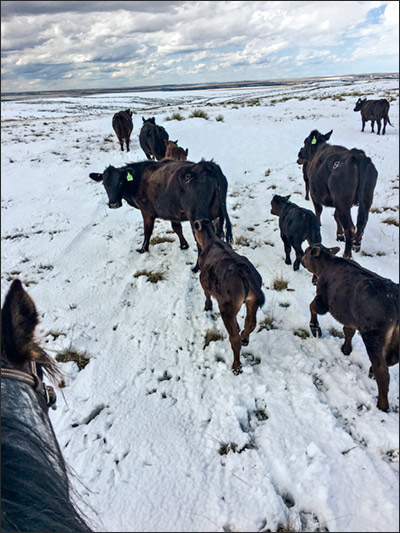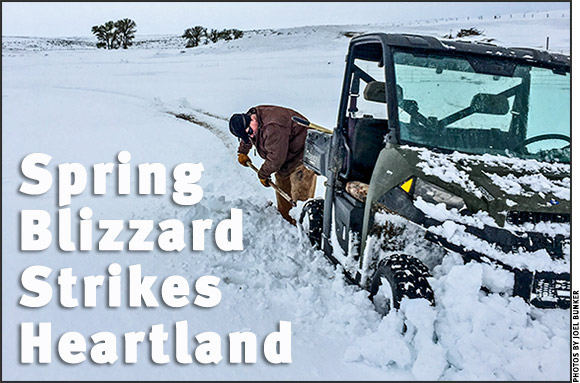Oklahoma’s Cimarron County reports 1,700 head of cattle dead after April weather event.
On April 29-30, 2017, an unexpected spring snowstorm plastered parts of eastern New Mexico and Colorado, the Texas and Oklahoma panhandles, and western Kansas and Nebraska with 12 inches (in.) to 24 in. or more of snow and 60 mph wind gusts.
While this region of cattle country is no stranger to harsh and sometimes erratic weather patterns, the devastation of the storm surprised most people in its path. The storm’s mid-spring timing and cocktail of wet snow and harsh wind left a trail of dead cattle, lost cattle, power outages, downed tree limbs and, in some places, 8-foot (ft.)-high snow drifts.

All of Bunker’s cattle were on pasture when the storm hit. He says for the first week after the storm, the cattle were tired, but he hasn’t seen any sickness in his calves.
Waking up to white
Ranch hand for Larson Angus Ranch and ABS Global Representative Brady Larson of Sharon Springs, Kan., says when he woke up Saturday, April 29, about 8 in. of snow blanketed the ground. He didn’t think much of it because by the end of day, the snow had melted. However, Sunday morning’s weather conditions surprised him.
“You looked outside and there was probably 18 to 20 inches on the ground,” he describes.
“Sunday was hard,” he continues, “because we lost power. … It’s just kind of an eerie feeling knowing there [are] cattle out there, and there isn’t anything you can do about it. I tried going out in the ranger around noon, and I got stuck 30 yards from the house, and I couldn’t budge.”
Southeast of Sharon Springs in Garden City, Kan., Lee Reeve, Kansas Livestock Association (KLA) president-elect and owner of Reeve Cattle Co., says what started out Friday and Saturday as a nice spring rain with good moisture accumulation turned into a blizzard the likes of which he had never seen before.
“By Sunday morning there was a couple inches more of snow everywhere, but then the storm really picked up, and it was blowing 40 to 50 mph. I have never seen as much snow in the air as what was there. It was a real heavy snow, so it was just almost like getting plastered with a snowball. I mean, it was just packing on everything,” recalls Reeve.
He says there was so much heavy snow dumped on the town of Garden City, roofs started to collapse because of the weight.
Down in Oklahoma, Cimarron and Texas Counties received their fair share of wind and snow. Oklahoma State Veterinarian Rod Hall reports the panhandle felt the weight of about a foot of snow but got upward of 60-70 mph winds. That created whiteout conditions, he says.
“Twelve inches of snow wouldn’t have been a bad issue on its own, but coupled with the wind, [it] just basically blinded the cattle, and they couldn’t see where they were going,” says Hall.
Hall describes a number of ways cattle perished in the storm:
- Feedlot cattle bunched in the corners of their pens and suffocated/trampled their pen mates closest to the fence;
- Pasture cattle drifted with the wind into and over fences;
- Blinded by the snow, several animals fell into swine farm lagoons and drowned.
Larson Angus Ranch lost young calves, older cows and a few feedlot cattle that had been battling illness at the time of the storm. Larson thinks in all but a few cases the stress of the storm was too much for the cattle to handle. Reeve echoes that sentiment, saying the cattle he lost in his feedyard were those that were already health-compromised for one reason or another.
Calculating the damage
There is no formal system in place for reporting cattle deaths, but in Cimarron County alone, Sherriff Leon Apple says he has heard a consistent number of 1,700 head. Hall says a rough estimate for Texas County, Okla., is 1,000 head.
There are still cattle missing in Oklahoma, so all numbers are subject to change.

KLA hasn’t compiled the death-loss numbers yet, but Reeve states the consensus among cattle feeders in the Garden City area is a loss of 20-40 pounds (lb.) each on cattle that were ready to be harvested.
While no one expected a storm of this magnitude this late in the year, all parties agree that it could have been much worse. Reeve is grateful it happened in April, when the ground was warm, instead of November. Larson says he’ll take a blizzard over a wildfire any time.
Hall says people in his area will be gathering cattle anyway for branding, so hopefully the lost cattle will be found and sent home.
Joel Bunker, a registered Angus seedstock breeder in Sharon Springs, Kan., says maybe the icing on the cake is that, “This year, if you buy bulls out of Kansas, you know they’re tough.”

Editor’s Note: Paige Nelson is a field editor and a cattlewoman from Rigby, Idaho.







